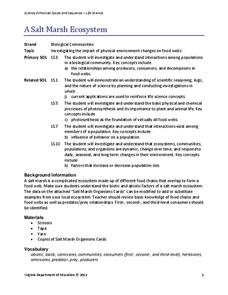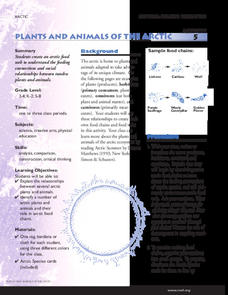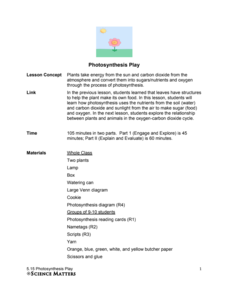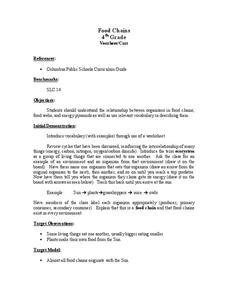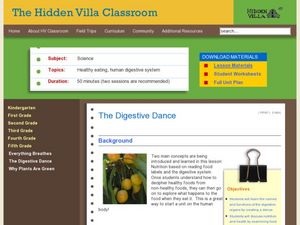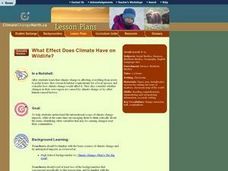Curated OER
Food For Keeps
Young scholars investigate the concept of food preservation. They use the internet to conduct research, specifically the methods of processing the students' favorite foods. They are introduced to the project using realia like beef jerky...
Curated OER
Food Safety-Consumers Need the Facts
Students begin by completing a survey asking them to rank their concerns about commercially prepared foods. They develop a definition of relative risk, and complete the "Pro or Con" worksheet. Students work in groups to make a study of...
Virginia Department of Education
A Salt Marsh Ecosystem
What a web we weave. Pupils use yarn as the primary resource to create a web depicting the intricacies of a salt marsh ecosystem. They participate in a question and answer session, which leads to an in-depth facilitated discussion...
Teach Engineering
The Great Pacific Garbage Patch
The Great Pacific Garbage Patch is one of several garbage patches around the world where garbage accumulates naturally. As part of a GIS unit that combines oceanography, environmental science, and life science, class members investigate...
National Wildlife Federation
Plants and Animals of the Arctic
The Arctic food web may be more limited than other environments, but it has all the same components. With an interactive activity, pupils assume the roles of the components of an Arctic food chain. They move around and link themselves to...
Beyond Benign
Lucky Brand Genes: Chromosome Cookies
Mutations are not just deformed creatures we see in movies—they happen every day! Scholars study the different types of genetic mutations in the 12th installment of a series of 18 lessons. A creative activity uses candy and other food...
California Academy of Science
Composting: A Scientific Investigation: California Academy of Sciences
Garbage, recycle, compost: Does it really matter where we put our trash once we are done? By making detailed observations over seven weeks, kids will see which materials break down naturally to become a healthy part of the soil, and...
Science Matters
Photosynthesis Play
Photosynthesis seems nothing short of magic: a little carbon dioxide and water, add energy, and poof, you get food! A thorough, collaborative lesson teaches youth the process of photosynthesis thanks to a skit they perform with a group...
Curated OER
Food Chains
Fourth graders investigate food chains. They review cycles and discuss ecosystems. They select an environment and create a food chain in small groups. They write their food chain and label it for the class to evaluate. They create...
Curated OER
Food Pyramid Menu
Students analyze the food pyramid. In this food pyramid lesson plan, students evaluate their nutritional needs. Students record their eating habits and determine if their food choices were healthy.
Curated OER
Forest Food Web
Students explore the elements of a forest ecosystem. They examine the elements needed to form a forest food web. Students construct and describe food webs that include nonliving elements of the ecosystem.
Curated OER
Food Chains
Young scholars investigate the food chain. In this ecology lesson, students define producers and consumers. Young scholars use organism cards to demonstrate how the food chain works.
Curated OER
Food Chain Chant
Students memorize a poem using various reading strategies to reinforce the concept of the food chain and the terminology associated with it.
Curated OER
Food Chains Are Not A Necklace!
Second graders examine how food chains interact with different plants and animals. They practice using new vocabulary. They also discover the role of pesticides in the environment.
Curated OER
Food Webs
Students research an animal to define its food web and life cycle. In this animal life cycle lesson, students research an animal and define its food web. Students then present their animal food webs to the class and note other animals in...
Curated OER
Food Webs
Learners create a bulletin board display illustrating food chains they make from a list of ocean organisms. Students also play a game showing what happens when one of the organisms is removed from the food chain and how they are all...
Curated OER
Food Webs
Students recognize interdependence in a food web by using yarn and notecards to create a food web and discussing what would happen if one of the organisms from a certain trophic level is removed.
Curated OER
Insect Food Chain & Camouflage
Students use art work to demonstrate their understanding of the insect food chain and their ability to camouflage themselves. In this insect food chain and camouflage lesson, students determine what type of animals feed on insects. They...
Curated OER
Talking about Food, Expressing Likes and Dislikes
Students explore foods. In this nutrition lesson, students chorally respond to questions about a kitchen PowerPoint, complete a Venn diagram about breakfast and lunch foods, and play a food Bingo game.
Curated OER
Step by Step
Young scholars explore agriculture by creating a food production diagram. In this farming lesson, students read assigned text about the entities that assist in food production companies such as farmers, truckers and supermarkets. Young...
Curated OER
The Digestive Dance
Learners read food labels to compare healthy verses non healthy food and then use diagrams to create a poster of the digestive system. In this food lesson plan, students move the food down the digestive track along the digestive system.
Curated OER
Producers and Consumers
Students make lists of producers and consumers and act as consumers that eat producers in a garden. In this producers and consumers lesson plan, students demonstrate a food chain by using a piece of yarn to connect all of them together.
Curated OER
What Effect Does Climate Have on Wildlife?
Students explore the international scope of climate change. They identify variables that cause changes in the climate. Students examine how changes in climate affect the food chain.
Curated OER
Raw Seafood ~ On the Half Shell
The topic is fascinating, but there is not much for learners to do here. Food borne illness has always been a problem for humans to face, and here, data from the Center for Disease Control is analyzed. Learners look at the number of...


